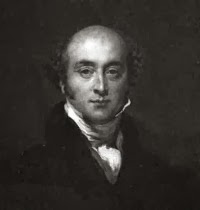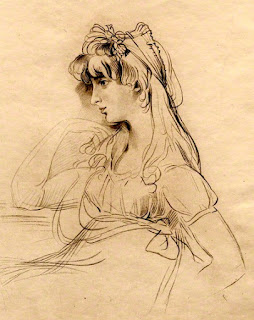 |
| Sir Thomas Lawrence from The Life and Correspondence of Sir Thomas Lawrence by DE Williams (1831) |
Sir Thomas Lawrence (13 April 1769 - 7 January 1830) was an English portrait painter and President of the Royal Academy from 1820-1830.
A child genius
Thomas Lawrence was born in Bristol on 13 April 1769, the youngest surviving child of Thomas and Lucy Lawrence. In 1773, the family moved to Devizes where his father was landlord of the Black Bear, a busy coaching inn.
 |
| Sir Thomas Lawrence as a boy from The Life and Correspondence of Sir Thomas Lawrence by DE Williams (1831) |
Lawrence was both good looking and talented. By the age of ten, he was producing pencil portraits of visitors to the inn and entertaining guests by beautifully reciting verse, especially Milton and Shakespeare. He sketched Lord and Lady Kenyon who stayed at the inn in 1779.1 The actor David Garrick was a frequent visitor and could not decide whether the boy’s future lay in acting or drawing.
In April 1780, Fanny Burney met Lawrence and records meeting “a most lovely boy of ten years of age, who seems to be not merely the wonder of their family, but of the times, for his astonishing skill in drawing.” She goes on to record in her diary that “Sir Joshua Reynolds had pronounced him, the mother said, the most promising genius he had ever met with.”2
The Bath years
Lawrence visited both Weymouth and Oxford, where “he took the likenesses of the most eminent persons then at Oxford”3 before moving to Bath where he became the chief earner in the family, his father having been declared bankrupt. He received encouragement from William Hoare, a fashionable portrait painter, and sold small pastel portraits, usually displaying a half-length, for three guineas a time. Lawrence also fell in love with the theatre at Bath, where he first saw Mrs Siddons.
In 1784, Lawrence was awarded the silver palette and five guineas by the Royal Society of Arts in London for his copy of Raphael’s Transfiguration.
The Royal Academy
 |
| Somerset House from the Thames from Leigh's New Picture of London (1827) |
In 1787, Lawrence moved to London and was admitted as a student to the Royal Academy. He started exhibiting at the Academy exhibition at Somerset House the same year.
In 1789, Lawrence was summoned to Windsor to paint Princess Amelia and Queen Charlotte, and on the death of Sir Joshua Reynolds in 1792, he was appointed painter-in-ordinary to George III and exhibited a picture of the King. He became a full member of the Royal Academy in 1794, at the earliest possible age of 25.
Lawrence supported the acquisition of the Elgin Marbles by the British Museum in 1816 and was appointed President of the Royal Academy in 1820 on the death of Benjamin West. He was elected a member of the Dilettanti Society in 1792 and succeeded Sir Joshua Reynolds as their appointed painter.
 |
| Some of the marbles bought by the British Museum from Lord Elgin in 1816 |
In 1802, Lawrence exhibited a full length picture of Caroline, Princess of Wales, and her daughter, Charlotte. During the course of the sittings at Montague House, Blackheath, he had necessarily become “very intimate” with the Princess of Wales and her daughter and “fame was busy in attributing his visits to improper motives”.4 His relationship with the Princess of Wales was questioned during the Delicate Investigation of 1806 but he was cleared of any impropriety.
 |
| Caroline, Princess of Wales from Memoirs of her late royal highness Charlotte Augusta by Robert Huish (1818) |
Lawrence was chosen by Princess Charlotte to paint her portrait as a gift to her husband, but she sadly died after childbirth in 1817, before the picture was finished. Lawrence records in a letter that he was “stunned by her death” and describes how the bereaved Prince Leopold was “greatly affected” when presented with the finished painting.5
The Prince Regent
In about 1810, Major General Charles Stewart had his portrait painted by Lawrence and the two men became friends. In 1814, Stewart encouraged the Prince Regent to have his portrait painted by Lawrence in field marshal’s uniform.
 |
| George IV from a drawing by Sir Thomas Lawrence c1829 drawn on stone by R Lane and printed by C Hullmandel © The Trustees of the British Museum |
The Regent was delighted with the result and proceeded to commission portraits of the allied sovereigns and their generals. Lawrence was knighted in April 1815 and in his travels over the subsequent years, he visited Paris, Vienna and Rome in fulfilment of his commission. The completed portraits now hang in the Waterloo Chamber at Windsor Castle.
What was Lawrence like?
As a young man, Lawrence was handsome and lively, as well as accomplished, despite his lack of formal education. He had polished manners and was an elegant dancer, fencer and billiard player as well as an excellent violinist and singer. Although noted for his kindness to his servants, some of his contemporaries found him rather too reserved.
 |
| Sir Thomas Lawrence from The Life and Correspondence of Sir Thomas Lawrence by DE Williams (1831) |
Lawrence did not underestimate his own talents. In a letter to his mother in 1786, he said that “excepting Sir Joshua, for the painting of a head, I would risk my reputation with any painter in London.”6
Although very hard-working, Lawrence was notorious for the speed with which he fulfilled his commissions. On his death, over a hundred unfinished paintings were found in his studio.
Throughout his lifetime, Lawrence struggled with his finances. It seems to have been a result of carelessness and overspending rather than profligacy. He was generous to both his family and other artists and spent large sums of money adding pictures to his collection. By 1807, he was more than £20,000 in debt and he died insolvent.
The loves of Lawrence’s life
 |
| Sarah Martha "Sally" Siddons by FC Lewis after Sir Thomas Lawrence Stipple engraving published 1841 © National Portrait Gallery, London |
In the 1790s, Lawrence was romantically involved with both Maria and Sally Siddons, Mrs Siddons’ two eldest daughters. He first fell in love with Sally and then Maria, only to break with Maria and return to Sally. Lawrence was forbidden to communicate any further with them and both sisters died young - Maria in 1798 and Sally in 1803. Lawrence never married.
According to Williams’ Life, Lawrence cherished an unrequited love for a Miss Upton, sister of Lord Templetown, for two years.7
Lawrence was very much attached to Mrs Isabella Wolff, the wife of a Danish consul, who separated from her husband in 1810, but Williams’ life describes this as a “more intellectual attachment”.8 He began a portrait of Mrs Wolff as early as 1803, but only finished it in time for the Academy exhibition of 1815. Another close friend, Miss Elizabeth Croft, wrote a detailed journal of the last week before Lawrence died.
 |
| Isabella Ann Wolff by Samuel Cousins after Sir Thomas Lawrence mezzotint published 1831 by P & D Colnaghi & Co © National Portrait Gallery, London |
Death
Lawrence died suddenly on 7 January 1830. He was given a public funeral on 21 January, with Sir Robert Peel and Lord Aberdeen among the pall bearers, and was buried in St Paul’s Cathedral.
Read about other Regency era painters - John Constable and Sir Joshua Reynolds.
Read about the Royal Society of Arts.
Notes
(1) Michael Levy notes the date of the Kenyons’ visit as 1779 rather than 1775 as stated in Williams’ Life Vol I p40. This suggests that the portraits were done when Lawrence was aged about 10 and not 6.
(2) From the Diaries of Madame d’Arblay, April 1780.(3) From Williams’ Life Vol I p67
(4) From Williams’ Life Vol I p254
(5) From Williams’ Life Vol II p82-3
(6) From Williams’ Life Vol I p83
(7) From Williams’ Life Vol II p101
(8) From Williams’ Life Vol II p102
Sources uses include:
Bell, John, La Belle Assemblée (John Bell, 1830, London)
Burney, Fanny, Diary and letters of Madame D'Arblay, edited by her niece, Charlotte Barrett (Henry Colburn, 1846, London)
Huish, Robert, Memoirs of her late royal highness Charlotte Augusta (1818)
Lawrence, Thomas and Williams, DE, The Life and Correspondence of Sir Thomas Lawrence, Kt (London,1831)
Leigh, Samuel, Leigh's New Picture of London (London, 1827)
Levey, Michael, Lawrence, Sir Thomas (1769-1830), Oxford Dictionary of National Biography (Oxford University Press, 2004; online edn, May 2011, accessed 5 Oct 2012)

Curious that none of Lawrence's sitters was unattractive. Had I been alive and rich in Regency London, I'd have insisted that he painted my portrait.
ReplyDeleteA useful post on an important Regency man.
Charlotte Frost
What an interesting observation. I believe that Queen Charlotte did not like the portrait painted of her in 1789 though and would not buy it! Maybe Lawrence learned to paint a little more kindly as he grew older.
ReplyDeleteA curiously under rated painter. Suffering from being homegrown and a 'society' artist? Or just too much of his time and a victim of changing fashions?
ReplyDeleteIn his time, Lawrence's skill was widely recognised as he held the cherished post as President of the Royal Academy and was patronised by George IV. Perhaps it was this connection with the unpopular king that later pushed his work out of fashion?
Delete